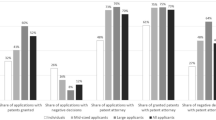Abstract
In the framework of the MONITOR-SPEAR programme of the Commission of the European Communities a critical review of the literature with regard to the utility of patent indicators being in use for evaluation world-wide has been undertaken. Availability, scope and complementarity of these indicators are discussed. A practical tool to use patent indicators for evaluation committees of EC programmes is designed and recommendations for EC procedures are given.
The suggested procedures will be implemented alongside three sample exercises. One of the exercise programmes is science-led (BEP and BAP), one industry-led (BRITE I) and one interphase (MHR). In this paper only selected examples with respect to the MHR programme are outlined and discussed.
The project is not completed yet and only preliminary findings will be given in this paper. From the viewpoint of its present state it is concluded that patent indicators may play a very useful role within a mixed set of evaluation procedures. The intersection with other methods is not very large, that is, patent indicators may provide supplementary information to a large extent. However, their use is limited to those types of programmes which are relevant for intellectual property rights mostly in the commercial realm. Patent indicators share with other evaluation tools the problem of best adjustment of time windows between observation and execution of the programme. Despite of these limitations, patent indicators may be employed properly as output indicators related to ongoing EC programmes, but as well for propective analysis of applied fields of R & D and may thus help in the definition phase of new R & D programmes.
Similar content being viewed by others
References
Chabbal, R., Die Organisation der Forschungsbewertung in der Kommission der Europäischen Gemeinschaften, CEC, Luxembourg, 1988.
Christiansen, J., Christiansen, L., Research on Research — Evaluation of Evaluations in the Nordic Countries, Copenhagen School of Economics and Social Science, Copenhagen, 1989.
Chung, S., Grupp, H., R & D policies in Germany and their evaluation (I): R & D Promotion policies and evaluation approaches,Journal of Science and Technology Policy, 2 (1990) 141–167
Gibbons, M., Georghiou, L., Evaluation of research — A selection of current practises, OECD, Paris, 1987.
Grupp, H., Schmoch, U., Technologieindikatoren: Aussagekraft, Verwendungsmöglichkeiten, Erhebungsverfahren, In:Bullinger, H.-J. (Ed.)Handbuch des Informationsmanagements im Unternehmen, München, Beck, 1991.
Grupp, H., The measurement of technical performance I. Framework of R & D intensity, technometric, and patent indicators, to be published (1990).
Grupp, H., Reiss, Th., Schmoch, U., Knowledge Interphase of Technology and of Science —Developing Tools for Strategic R & D Management, ISI Report, Karlsruhe, 1990.
Irvine, J.,Evaluating Applied Research: Lessons from Japan London, Pinter, 1988.
Laredo, P., Callon, M., L'impact des programmes communautaires sur le tissu scientifique et technique français, Ministère de la Recherche et de la Technologie, Paris, 1990.
Lovio, R., Technology indicators as a medium for evaluation of research, In:Evaluation of Research — Nordic Experiences, Nordic Science Policy Council, FPR publication No. 5: Copenhagen, 1987.
Marcy, W., Kosloski, B.M.,Study of Patents Resulting from NSF Chemistry Program, Research Corporation, New York, 1982.
Meyer-Krahmer, F., Montigny, Ph., Evaluation of innovation programmes in selected European countries,Research Policy, 18 (1989) 313–332.
Meyer-Krahmer, F., Recent results in measuring innovation output,Research Policy, 13 (1984) 175–182.
Nelson, R., Winter, S., In search of a useful theory of innovation,Research Policy, 6 (1977) 36–76.
Ormala, E., R & D project evaluation for selection, In:Ormala, E. (Ed.), Evaluation of Technical Research and Development, Espoo; NORDFORSK, 1987, pp. 28–48.
Ormala, E., Nordic experiences of the evaluation of technical research and development,Research Policy, 18 (1989) 333–342.
Schmoch, U., Grupp, H., Patents between corporate strategy and technology output: An approach to the synoptic evaluation of US, European and West German patent data, In:Van Raan, Nederhof, Moed (Eds.)Science and Technology Indicators, Leiden, DSWO Press 1989.
Schmoch, U., Grupp, H., Mannsbart, W., Schwitalla, B.,Technikprognosen mit Patentindikatoren, Köln, Verlag TUEV Rheinland, 1988.
Tanaka, M., Japanese-style evaluation systems for R & D projects: The MITI experience,Research Policy, 18 (1989) 361–378.
Note added in proofs: The investigation has been completed in April 1991 and is being published in two volumes by CEC:Schmoch, U., Grupp, H., Kuntze, U.,Patents as Indicators of the Utility of EC Research Programmes, Vol. 1: Presentation of Results, Vol. 2: Methodology, Tables, Figures, and Lists, Brussels, CEC, 1991.
Author information
Authors and Affiliations
Additional information
This work has been sponsored by the MONITOR programme of the Commission of the European Communities.
Rights and permissions
About this article
Cite this article
Grupp, H., Schmoch, U. & Kuntze, U. Patents as potential indicators of the utility of EC research programmes. Scientometrics 21, 417–445 (1991). https://doi.org/10.1007/BF02093979
Received:
Issue Date:
DOI: https://doi.org/10.1007/BF02093979




